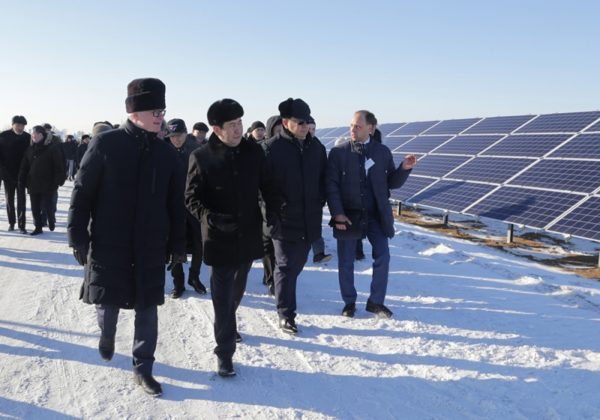
Green Investment Receives a Boost in Kazakhstan
Publication: Eurasia Daily Monitor Volume: 18 Issue: 95
By:

The COVID-19 pandemic recovery in Central Asia is taking an unexpectedly green turn. Three of the five Central Asian states boast large hydrocarbon resources and, ever since becoming independent from the Soviet Union 30 years ago, have relied primarily on oil and natural gas revenues. But now, Kazakhstan and Uzbekistan are undertaking green energy and green economy programs that promise to bring significant environmental, economic and social change to Central Asia (Ebrd.com, November 16, 2020; Renews.biz, April 9, 2021). The return of the United States to the Paris Agreement on climate change, the Joseph Biden administration’s plans to boost green economic development at home and abroad, as well as the European Green Deal have all inspired oil-producing countries in Eurasia to channel pandemic recovery initiatives into an environmental agenda.
Green energy projects require significant initial financing that even countries endowed with natural resources do not always possess. Although oil prices have recuperated since the global crash in March–April 2020, their rise was slow amidst plunging demand during the pandemic (Investopedia, January 9). Central Asia’s biggest oil economies are now ready to diversify and reduce their dependence on fossil fuel revenues, however. Increased cooperation with the US, combined with the availability of green financing instruments, are likely to bring faster recovery and transform the region’s economies over the long term.
In January, the US, Kazakhstan and Uzbekistan launched the Central Asia Investment Partnership to promote private-sector growth and strengthen regional cooperation in the aftermath of the pandemic (Kz.usembassy.gov, January 7). The US International Development Finance Corporation and its Kazakhstani counterpart, the Astana International Financial Center (AIFC), committed to raising at least $1 billion over the next five years to advance private sector–led projects that promote sustainable investments protecting nature. Continuing US support for this initiative will be critically important to its success.
Green financing has been a priority for AIFC since its inauguration three years ago. Modeled on the Singapore and Dubai financial centers, AIFC is one of the last legacy projects of Kazakhstan’s first president, Nursultan Nazarbayev, before he stepped down from office the following year. AIFC’s Green Finance Center was established to attract investment in environmental and social projects in Kazakhstan and throughout Central Asia. Its impact was recognized in the 2021 Global Green Finance Index, which assesses the depth and quality of the green finance offerings by 78 international financial centers around the world (Longfinance.net, April 29). It has placed the international financial centers in Nur-Sultan (AIFC) and Almaty (Almaty Financial District) ahead of all Central and Eastern European financial centers, including Prague, Moscow and Warsaw. It might be a long time before Kazakhstan realizes its ambition to develop AIFC as one of the top ten financial centers in Asia; and yet its green finance offerings have already put it among the top 14 Asian capitals.
AIFC is independent of Kazakhstan’s legal system and operates according to the United Kingdom’s securities and corporate law. It has an independent court and arbitration, headed by British jurists, and offers visa waivers and a preferential tax regime. Not only international companies but also local businesses are now considering using the court to resolve disputes, as they are often frustrated with the national court system, which is ill-equipped to deal with complex business arbitrages. Among the perks for AIFC’s 792 registered member companies are exemptions from Kazakhstani corporate income tax, individual income tax, and land and property tax for 50 years (Aifc.kz, accessed June 12).
In 2020, AIFC’s stock exchange, the Astana International Exchange, where Nasdaq and the Shanghai Stock Exchange are shareholders, made its first offering of green finance bonds to help small- and medium-sized businesses invest in renewable energy projects (Aix.kz, accessed June 12, 2021; Kazinform, August 11, 2020). Kazakhstan has over 85 percent of Central Asia’s solar potential, making it well-positioned to become a solar energy hub. Solar plants and farms have been built with backing from the European Development Bank, the Green Climate Fund and the Climate Investment Funds, as well as German and Chinese investors (Ebrd.com, September 18, 2020; RFE/RL, January 26, 2019). The country plans to generate half of its electricity needs through renewable resources by 2050.
The coronavirus pandemic had a devastating effect on Central Asia’s economies (see EDM, August 10, 2020). The World Bank found that the fallout from the various lockdowns and trade disruptions associated with COVID-19 hit Kazakhstan’s economy, the largest in the region, more than the financial crisis in 2008 or the oil price crash in 2015 (Worldbank.org, December 2020). It shrank by 2.5 percent in 2020, the worst year for the country in two decades. The most impacted have been the retail, hospitality, wholesale and transport sectors, which account for around 30 percent of employment in Kazakhstan’s urban centers. Pandemic restrictions affected some 800,000 enterprises or more than 60 percent of all small and medium businesses (Liter.kz, September 25, 2020).
In addressing the COVID-19 fallout, Kazakhstani President Kassym-Jomart Tokayev has outlined the need for reforms to increase foreign direct investment. Consequently, the government created an investment Task Force, with AIFC as its cornerstone, charged with verifying investment proposals submitted by state bodies and private businesses through its Business Connect platform (Astana Times, April 15). According to Foreign Minister Mukhtar Tileuberdi, projects that have passed the verification process will be accompanied by the Task Force all the way from development to implementation.
Although the World Bank expects a modest upturn this year, the Asian Development Bank forecasts that if government support for local businesses is sufficient, pandemic recovery could be much faster, with economic growth rebounding at 4.6 percent (Adb.org, February 1). The population’s real income could grow by 3.4 percent, while consumption could increase by 3.9 percent compared to 2020. Such positive outcomes will largely depend on increased foreign direct investment, including from the US and Europe, that Kazakhstan is hoping to attract with a new focus on green economic projects.



